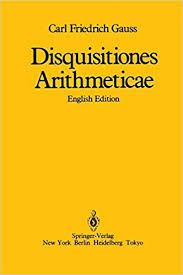The problem with number theory was that up until the nineteenth century it was essentially a collection of individual or independent results. A general approach was needed that would include many results from the past, make new discoveries and suggest new avenues of inquiry.
The man who would supply this much needed, general approach was Carl Friedrich Gauss (1777 – 1855).
In the time of Gauss, number theory was referred to humbly just as arithmetic or sometimes more a little more fulsomely as higher arithmetic. It was Gauss' favorite area of mathematics:
And it was in arithmetic that Gauss produced his first and perhaps greatest masterpiece:
Disquisitiones Arithmeticae
You can page through or download
at the Internet Archive
In this work, Gauss was able to break arithmetic out of its box by essentially creating a new kind of arithmetic called modular arithmetic dealing with congruences:
a is congruent to b, modulus n means simply that a and b have the same remainder when divided by n, or in other words n divides (a - b) without remainder.
Modular arithmetic is sometimes called clock-face arithmetic because you can arrange the numbers from 0 to n like the numbers on a clock and then essentially continue to add numbers in a spiral, round and round showing their congruences. Here is the spiral for modulus 5:
 |
| Module 8: Basic Number Theory |
Modular Arithmetic not only revolutionized number theory but found applications in an amazing variety of areas, as noted in Wikipedia:
In theoretical mathematics, modular arithmetic is one of the foundations of number theory, touching on almost every aspect of its study, and it is also used extensively in group theory, ring theory, knot theory, and abstract algebra. In applied mathematics, it is used in computer algebra, cryptography, computer science, chemistry and the visual and musical arts.
It is taught as the essential, keystone element of the entire field of Discrete Mathematics:











No comments:
Post a Comment
Note: Only a member of this blog may post a comment.